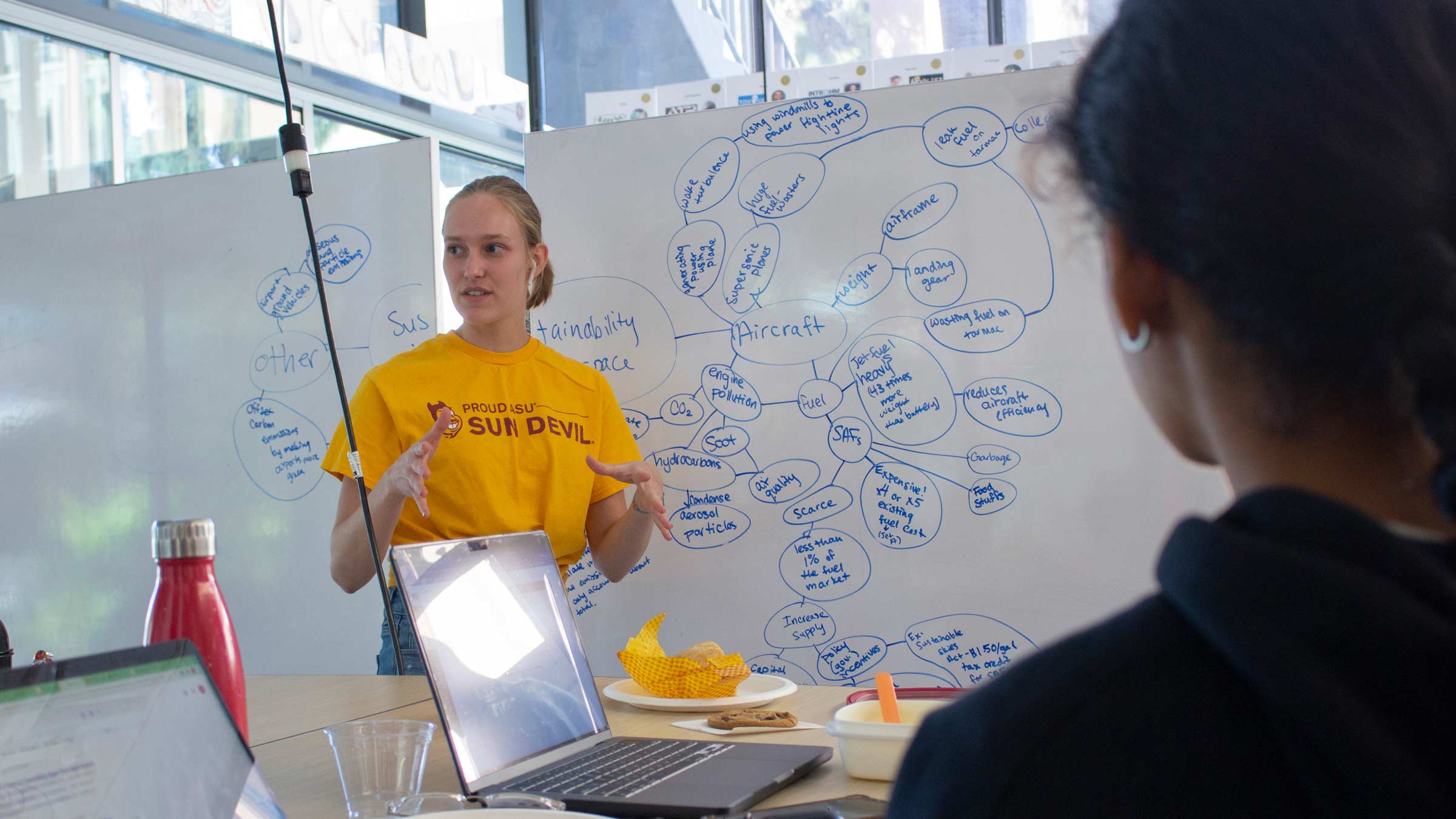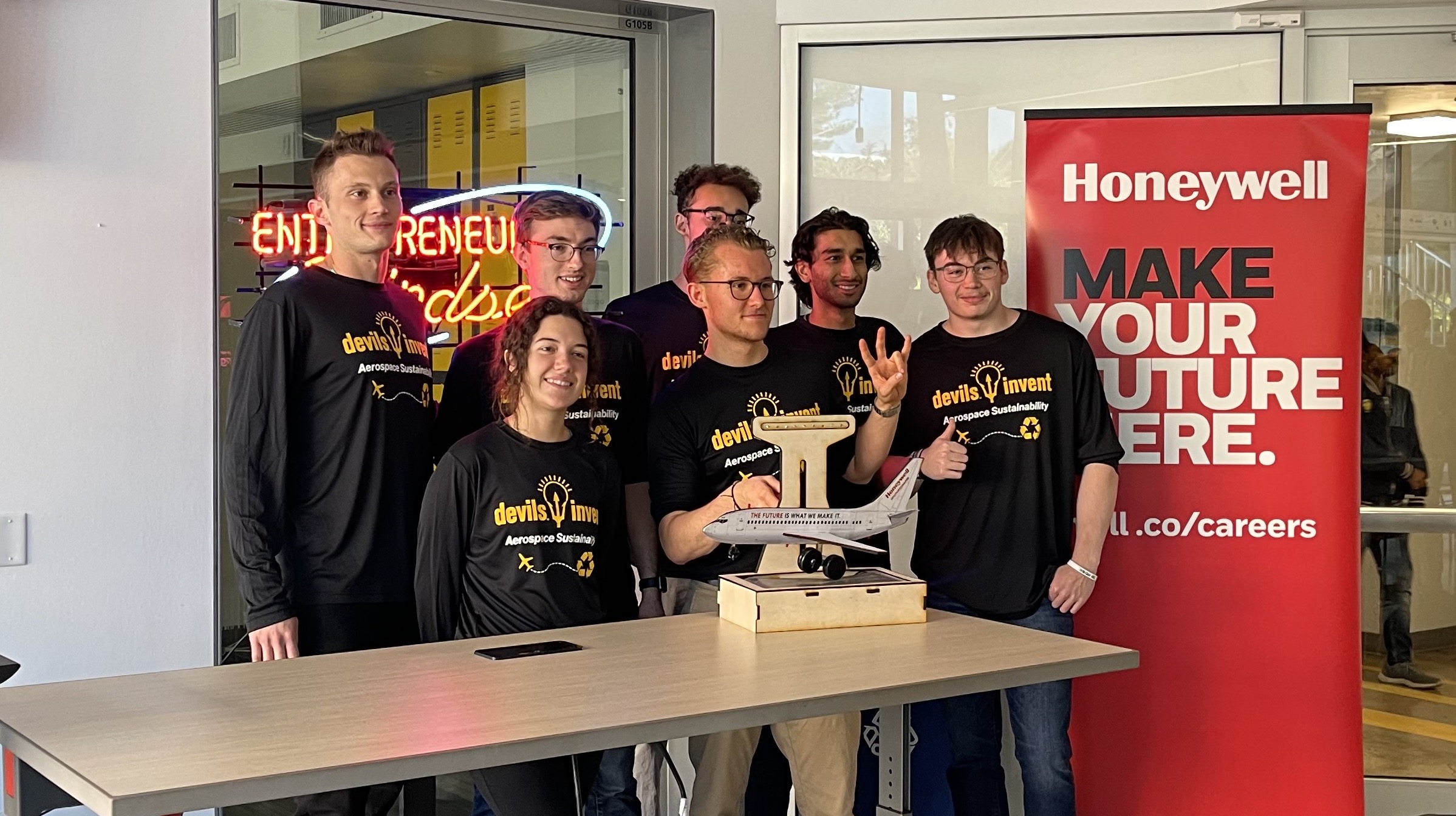
ASU students explore ideas for aerospace sustainability

In November 2021, the Federal Aviation Administration published the United States Aviation Climate Action Plan, with the goal of putting the country on a path toward achieving net-zero emissions in the aviation industry by 2050.
The plan builds on commitments announced by companies with roles in the U.S. aviation industry, like Honeywell, to be carbon-neutral by 2035. Honeywell recently sponsored Devils Invent: Aerospace Sustainability, a three-day design challenge hosted by the Ira A. Fulton Schools of Engineering at Arizona State University.
During the weekend-long challenge held in November, students sought solutions to make the aerospace field more sustainable. The event provided a hands-on opportunity for student teams to practice designing real-world solutions.
“While some students may have trouble giving up one of their weekends, those who do find it to be immensely worthwhile,” says Anthony Kuhn, assistant teaching professor and director of the Fulton Schools design experiences, including Devils Invent. “Student teams are able to go through a full design cycle in a fraction of the time they might spend doing similar activities in class.”
Honeywell’s sponsorship stems from their carbon-neutral pledge and the company’s desire to generate ideas and prepare future sustainability engineers to help achieve that goal. The event also spotlights the role the engineering and aviation industries can play within ASU’s learning environment. Honeywell provided prizes for the best ideas and mentors to work with the students during the event, as well as job opportunities.
“Honeywell is committed to driving transformation to a sustainable future,” says Rob Anchondo, Honeywell’s engineering vice president and chief technology officer for services and connectivity.
“Our team continues to be highly impressed with the students of ASU and their ability to contribute to this vision,” Anchondo says. “We look forward to furthering our relationship so that we can all learn and grow together to ensure a sustainable future for the next generation.”

The H.DOLMUS team won first place at Devils Invent: Aerospace Sustainability. Team members include: Heather Palfreyman, Udayketan Mohanty, Deandre San Agustin, Matisse De Roo, Luc Teachout, Sam Krochman and Oscar Kozieja Photographer: Kati Martinez/ASU
Harvesting energy
The top prize of $5,000 went to the H.DOLMUS team and their energy harvesting idea that incorporates a regenerative braking design.
Their energy harvesting design uses a supercapacitor onboard an aircraft to store kinetic energy generated during landing. The stored energy would be used to taxi back out to the runway, which reduces the use of the auxiliary power unit system, saving fuel and minimizing emissions.
“An additional aspect of our project was a static electricity energy harvesting pitch,” says Oskar Kozieja, a third-year mechanical engineering major in the Fulton Schools. “During flight, airplanes build up a lot of static electricity, so our goal was to repurpose this electricity into something useful such as lighting up the cabin.”
Kozieja, who was participating in his third Devils Invent, is a member of the Fulton Schools’ Formula SAE Brakes subsystem team and says it would be interesting to see the braking idea scaled up to be used on an airplane.
“I love participating in these design challenges,” Kozieja says. “They are a great way to challenge yourself and learn how you perform with a team during a time constraint. There are so many opportunities to get involved at ASU, and this is one of them.”

The Houston team included students Sydney Lenski, Adithi Muruganandam, Anirudh Manjesh and Sadie Cullings and took second place at Devils Invent: Aerospace Sustainability. Photographer: Kati Martinez/ASU
Passively collecting electricity
The $3,000 second-place award went to the Houston team and the idea to collect passive electricity by utilizing the weight of airplanes on a taxiway covered with piezoelectric plates. Piezoelectricity involves the generation of electricity from applied pressure.
“Our idea was to lay plates containing piezoelectric crystals on the taxiway of an airport, and whenever an aircraft drives over the plates the sheer weight of the aircraft on its surface would create electricity that could then be used to power the airport,” says Sydney Lenski, a first-year mechanical engineering major.
The electricity generated can be tracked on an app designed by Houston team member Anirudh Manjesh, a first-year computer science major. The app will calculate how much money the airport is saving in energy costs, as well as the subsequent reduction in atmospheric carbon emissions from generating renewable energy.
Aerospace sustainability is an area of immense interest to second-year aerospace engineering major Sadie Cullings.
“The theme allowed me to encompass my passion for coming up with new technologies to support the industry that I plan on being a part of,” Cullings says. “I’m currently studying aerospace engineering, with a focus on astronautics, so the second I saw the theme for Devils Invent, I thought to myself, ‘I have got to do that; this speaks to me on multiple levels.’”
Lenski found multiple aspects of the Devils Invent challenge interesting.
“The challenge of applying what you learn in class to issues that thousands of engineers are trying to solve and the excitement of coming up with a tangible solution is thrilling,” Lenski says. “I must say, the thing I enjoyed most was working with my team.”
If schedules permit, the team of four — Lenski, Manjesh, Cullings and first-year mechanical engineering major Adithi Muruganandam — plans to reunite in the spring for the next Devils Invent challenge.
“Throughout the whole process, although it was rigorous and there were a lot of stressful moments, we found time to have fun and really get to know each other,” Lenski says. “I’m so glad to have met them.”

The third place STEM-inists consisted of Oceane Ingram, Addison Sonora, Anastasia Ivanova, Noemi Santana Gonzalez, Sharmila Nimbkar and Yibo Chen. Photographer: Kati Martinez/ASU
Converting exhaust to electricity
The $2,000 third-place prize went to the STEM-inists team for their idea to take advantage of the thermal waste energy in airplane exhaust. By diverting the exhaust to a thermoelectric generator, the team’s concept would eliminate fuel use by the auxiliary power unit and integrated drive generator.
“Most internal combustion engines, including jet engines, have an efficiency of only around 30%, meaning that 70% of the fuel burned just converts to useless heat energy,” explains Sharmila Nimbkar, a third-year mechanical engineering major. “Our project involved venting hot jet exhaust through the existing bleed air system within a plane’s wings, which is normally used only to defrost the wings.”
Nimbkar says thermoelectric materials can generate electricity from temperature gradients, so coating the plane wing in thermoelectric material could use the difference between the hot exhaust air bled through the wing and the cool atmospheric air flowing over the wing to generate electricity.
“By our estimate, nearly the entire in-flight auxiliary power for a commercial flight could be generated this way, reducing fuel consumption,” Nimbkar says. “The most exciting part of the project was being able to apply what I learn in class to real-world problems. As soon as I started researching and finding flow rates and efficiency values, I remembered thinking, ‘Wait, I know what to do with these.’”
Though this project itself will be left as a theoretical it has sparked interest in planes and aviation for sophomore computer science major Anastasia Ivanova.
“I had not looked into aerospace engineering before but I have always loved physics,” Ivanova says. “After the project, I found myself very interested in the matter and have even talked to several people in the field about some lingering questions I had from my research for Devils Invent.”

The Aero Reloaded team of Malik Labban, Adam Podbielski, Carlos Moran-Esparza, Brendan Graves, Michael Leef and Bailey Pocock took fourth place at Devils Invent: Aerospace Sustainability with an idea to improve airplane fuel consumption. Photographer: Kati Martinez/ASU
Improving taxiing efficiency
A $1,000 fourth-place prize was awarded to Aero Reloaded for the team’s idea to improve the taxiing process of planes on the tarmac.
“Taxiing on a commercial plane averages around 30 minutes before a plane is taken to the runway for takeoff,” says Michael Leef, a third-year electrical engineering student. “In this period alone, this accounts for 15% to 17% of the plane’s fuel.”
Team members wondered what would happen if they reimagined how planes are brought to take off and removed from the runway — while removing the component of human error.
“Our project addresses this by automating and electrifying the tug vehicles to bring a commercial plane out to the runway from the gate,” Leef says. “By automating it, we can achieve a synchronous system to get planes into the sky in an optimal order and delivering the plane to the runway.”
The team looked specifically at airport operations to find ways to reduce fuel use the most.
“It’s extraordinary how much fuel goes into taxiing alone, compared to the time in the sky,” Leef says. “If we could fundamentally change this aspect at airports, a large amount of fuel can be saved annually.”
A rewarding event
Devils Invent: Aerospace Sustainability set out to impart to students the importance of a sustainable future for aerospace and provide them the opportunity to develop inventive solutions as well as give the students exposure to the industry.
“Sponsored events like this add even more value to students who spend their weekend with us,” Kuhn says. “In a short period of time, they get to learn more about engineering as a career, practice working on the sorts of problems the industry sponsor is trying to solve, and have what is essentially a casual interview with hiring managers.”
Anchondo, who is a Fulton Schools alumnus, says the event surpassed expectations.
“The attendance was phenomenal and the dedication and passion exhibited by the students inspires confidence in the next generation of engineers and scientists,” Anchondo says.
“I could not be more proud of the incredible environment that ASU fosters; bringing together amazing faculty and inspirational students,” he says. “I left excited, knowing that this next generation of future shapers is already innovating great solutions for a sustainable future.”



































